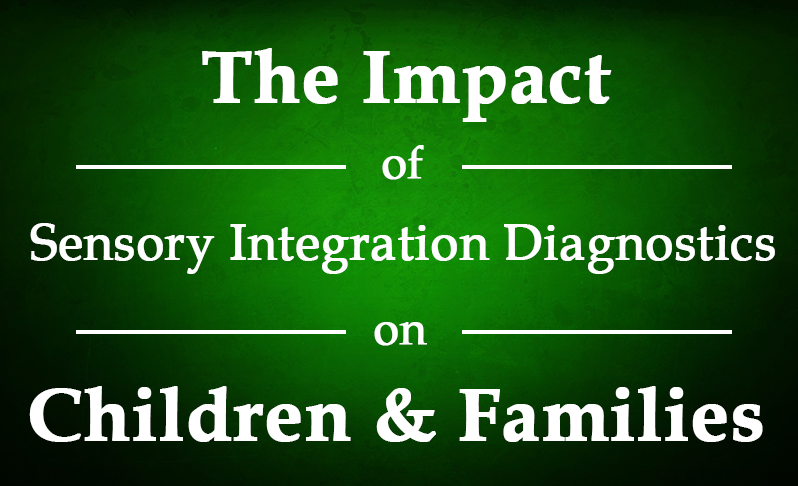The diagnostic process plays a central role in the lives of people living with sensory processing challenges and autism. (Tweet this quote.) Diagnostic decisions shape therapeutic directions, financial needs, and lifestyle choices. The quest for diagnostic accuracy and clarity is time consuming, frustrating, and emotional. It is also exhausting. Ironically parents can become overwhelmed and unable to easily filter all the lingo, bureaucracies, and paperwork involved in the diagnostic process. Then they face the arduous search for therapies and therapists.
Even before the diagnostic odyssey begins, parents have been through anxiety, ambivalence and apprehension as they try to understand their child’s behavior. Then, once the quest has been launched parents have to sort out various opinions, multiple diagnoses, and even conflicting ones. This journey has a complex itinerary.
A Family That Learns and Grows Together
The family becomes educated and enlightened through an arduous process. They may be completely unfamiliar with the world of sensory resources and end up by becoming leaders for others. I am deeply impressed with all the families I have met, many of whom you can meet in the pages of my book. They emerge with a grounded assurance and faith that they will find their way through the red tape and lingo to the truth about their child. In the process, more and more loving intelligence emerges that strengthens and sometimes even builds from the ground up the cohesion of family unity.
Parents and families deserve and need to be fully informed as they make their wholehearted efforts to understand and serve their sensory needs children. (Tweet this quote.) There is terminology, biomedical information, therapeutic and diagnostic acronyms, and research and lifestyle accommodations to assimilate. The skills of advocacy have to be acquired. In cases where there are multiple siblings with sensory needs the learning curve becomes even steeper as each child will have unique criteria.
The Sensory Integration Diagnosis Process
The cycle of the diagnostic process may look something like this:
- Observing the uniqueness and difficulties of your child and becoming curious;
- Positing and researching sensory processing and autism criteria;
- Minimizing your child’s difficulty and seeing it as something that will pass;
- Becoming anxious and concerned that something is really wrong;
- Talking to others and reconsidering your observations and your child’s behavior;
- Seeking opinions and observations of family members and friends;
- Speaking to healthcare providers;
- Making the decision to request a professional opinion;
- Seeking second and possibly third opinions and more;
- Sorting through the information you receive;
- Resonating with a diagnosis that matches your understanding of your child and his behavior;
- Sharing the diagnosis with family and friends for confirmation, guidance and support;
- Evaluating appropriate therapies;
- Interviewing therapists;
- Continuing to do research and exploring multiple options that are available for your child;
- Seeking training and skills for yourself to support your child and build a therapeutic environment at home;
- Becoming empowered and inspired;
- Advocating for your child;
- Understanding your new role as parent;
- Developing a theory of mind for your child;
- Finding support; and
- Being a lighthouse to others with special needs children.
This is a roller coaster for the whole family. Extended family, care providers, and friends can be invaluable allies when they communicate faith in the child’s innate health, intelligence and creativity and when they enforce the power of the family to be a container of love.
Advocacy Is the Light at the End of the Tunnel for Parents in the Diagnostic Whirlwind
As rough as the waters are on this voyage parents will return over and over to seeing the purpose of it all from the perspective of the child’s development. Underlying all aspects of the diagnostic experience is the role of education for everyone in the family. Our sensory needs children and youth fuel their parent’s education as they are impelled to learn how the brain functions and what sensory integration really is. The most uplifting education is in the way parents learn who their offspring really are and the nature of the bond that they share. Despite distress and sometimes crushing obstacles the entire process is one of expansion. Those of us in this worldwide community must never lose sight of this.
Author
 Dr. Stephanie Mines is a psychologist whose unique understanding comes from her academic research as well as her extensive work in the field. Her stories of personal transformation have led many listeners to become deeply committed to the healing journey. Dr. Mines understands shock from every conceivable perspective. She has investigated it as a survivor, a professional, a healthcare provider, and as a trainer of staffs of institutions and agencies. Meet Stephanie.
Dr. Stephanie Mines is a psychologist whose unique understanding comes from her academic research as well as her extensive work in the field. Her stories of personal transformation have led many listeners to become deeply committed to the healing journey. Dr. Mines understands shock from every conceivable perspective. She has investigated it as a survivor, a professional, a healthcare provider, and as a trainer of staffs of institutions and agencies. Meet Stephanie.




